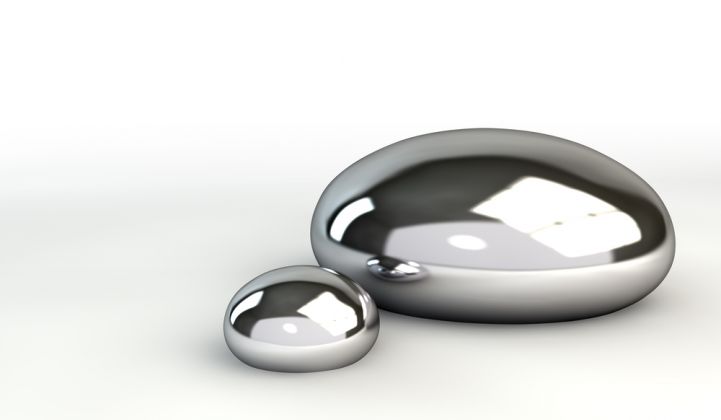David Bradwell, the CTO, co-founder and SVP of liquid-metal battery startup Ambri, spoke on Thursday at Infocast's Energy Storage Week.
We've covered the Ambri story in detail.
- The inventor of the core technology for the battery is Don Sadoway, MIT professor of materials chemistry, with technology inspired by the economy-of-scale of modern electrometallurgy and the aluminum smelter.
- Sadoway used seed money from within MIT to invent the liquid metal battery, using a technology called Reversible Ambipolar Electrolysis.
- Ambri raised a $15 million Round B from Khosla Ventures, Bill Gates and energy company Total in 2012.
Bradwell said a grid-scale battery needs to be resilient, safe and low-cost. The three layers in the Ambri battery are self-segregating, cheap to manufacture and earth-abundant. The materials used in the original design were magnesium and antimony separated by a salt -- but "we needed higher voltage and lower temperature," said the CTO, and so the firm has a new, undisclosed chemistry arrived at with the help of ARPA-E funding.
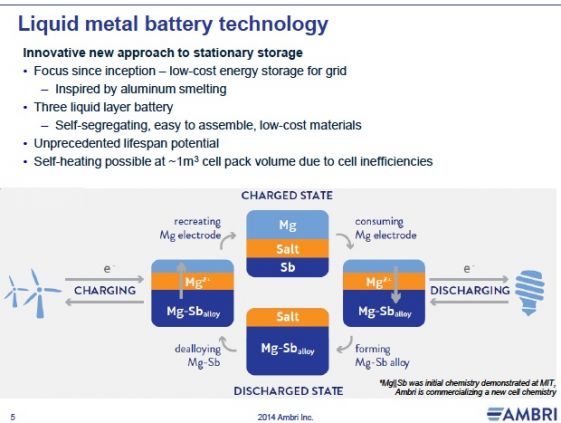
Prototype units started as the "shot glass," followed by the 3-inch, 20-watt-hour "hockey puck," and then by the 6-inch, 200-watt-hour "saucer." The commercialized product will use a 6-inch square.
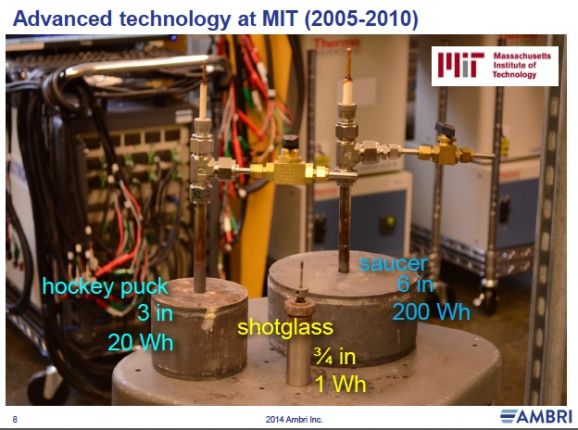
Bradwell notes that the batteries achieve 1,000 cycles of continuous deep cycling with negligible fade. There are no moving parts, pumps or valves in the design.
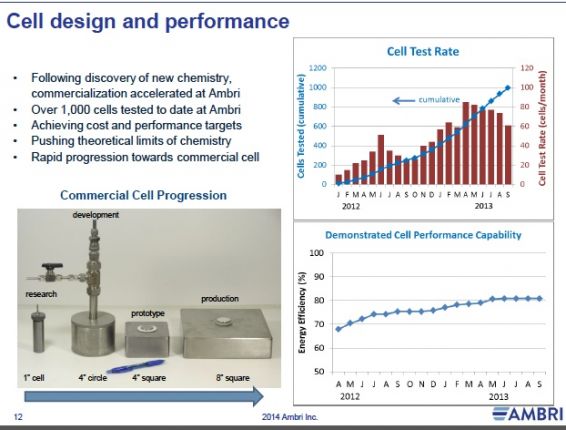
The cell is contained in a 4-inch-by-4-inch stamped stainless steel housing with no nanoscale microstructures or difficult-to-synthesize materials, according to the co-founder.
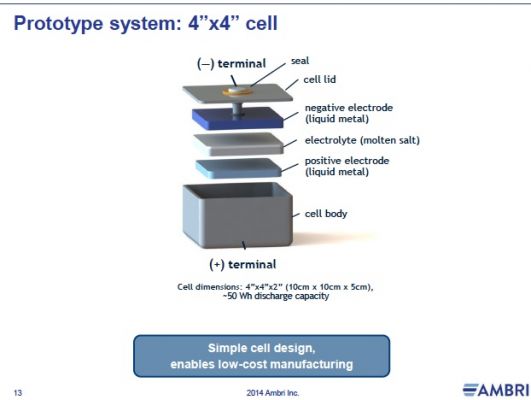
The cells have a DC-to-DC efficiency of 80 percent at a five-hour charge/discharge rate and an AC-to-AC efficiency of 70 percent to 75 percent.
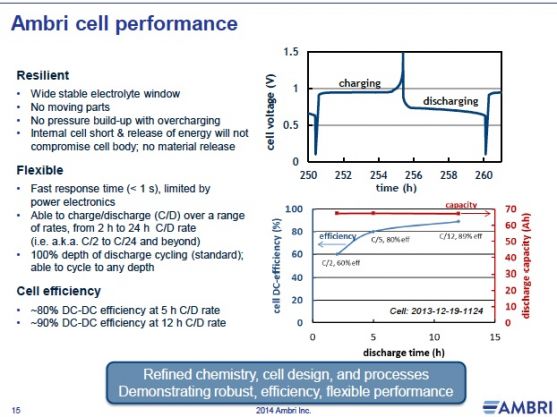

Ambri hopes to have its first scaled 20-kilowatt-hour units operational early this year, with 35-kilowatt-hour commercial units coming in 2015. A larger system will reach 200 kilowatt-hours in 3 cubic meters. The 10-ton weight of that unit will serve as an effective theft deterrent, joked Bradwell.
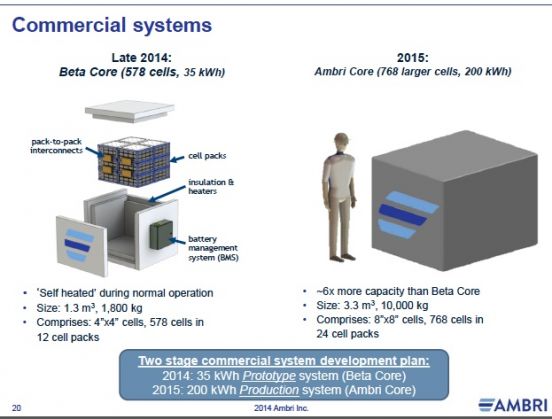
The company's pilot project in Hawaii will have two cores installed this year in partnership with First Wind and HECO, with funding from the DOE- and ONR-sponsored Hawaii Energy Excelerator. The goal is to improve integration of solar power and reduce wind curtailment.
Another project at Joint Base Cape Cod will see deployment of a 35-kilowatt-hour prototype to improve grid security and reliability.
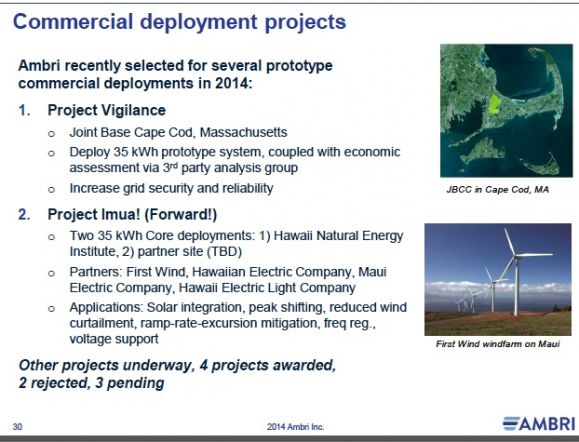
Bradwell noted that all manufacturing processes and robotic cell assembly had to be developed by Ambri. He claims a lower manufacturing cost and lower employee-per-square-foot-of-factory ratio than that of lithium-ion battery technology. The CTO also suggested that Ambri's pricing will fall between pumped hydro and CAES.
Ambri investor Vinod Khosla is not a big fan of lithium-ion batteries and has funded a number of other energy storage companies including Pellion, LightSail, QuantumScape, and Seeo. Aquion, funded by KPCB, ATV and Foundation Capital, is developing a saltwater electrolyte-based system. Eos has a zinc-air battery with some customer traction. Stanford University technology can be found in Huggins Group battery startup Alveo Energy. There are dozens more startups aiming for utility-scale energy storage working with compressed air, mechanical systems, flow batteries, and other electrochemical means.
There is a load of VC investment thinly spread in this field -- and a familiar reckoning awaits.
Keep in mind that while these startups struggle for their first megawatt of energy storage production, AES has installed more than 100 megawatts of energy storage. Incumbents with heft, such as S&C, Siemens, ABB and GE, are deeply engaged with this problem as well.
In an earlier presentation at this event, Tad Glauthier, VP at storage system vendor Stem, cited Ambri and Aquion as new battery vendors with potential price-competitiveness. He noted that improvements in lithium-ion technology are small and incremental, while changes in battery technologies' price points have the potential to change the size of the market. Glauthier sees near-term battery price reductions reaching one-half to one-third of lithium-ion, falling to sub-$100 per kilowatt-hour levels before 2020.
MIT's Don Sadoway on Ambri technology
